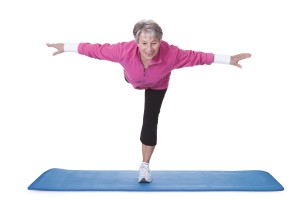January 19, 2015
 As a child you fall all the time, but as an older adult, a fall can be a devastating event, which is why preventing falls is extremely important. If you have taken a tumble, you wouldn’t be alone—each year, millions of adults aged 65 and older fall, according to the Centers for Disease Control and Prevention.
As a child you fall all the time, but as an older adult, a fall can be a devastating event, which is why preventing falls is extremely important. If you have taken a tumble, you wouldn’t be alone—each year, millions of adults aged 65 and older fall, according to the Centers for Disease Control and Prevention.
Being cautious as you walk is good, but preventing dangerous falls takes more than caution, especially for frail individuals. The best way to prevent falls is being physically fit and strong. The better your physical condition, the less likely you are to be injured. Regular exercise, including balance drills, can help seniors gain the muscle strength needed to prevent a fall.
Lack of exercise can lead to weak legs, and this increases the chances of falling. Exercise programs such as Tai Chi can increase leg strength and improve balance, making falls much less likely. If it’s a possibility, try out a few simple Tai Chi moves, or take a walk around the block or even around the home. Seniors who walk typically have a lower incidence of obesity, arthritis, heart disease and diabetes, and longer lifespans than people who are sedentary.
And because fall risk and physical fitness go hand in hand, here are a few senior-specific exercise tips:
- Wait at least two hours after eating before vigorous exercise.
- Exercise only when feeling well.
- Drink plenty of fluids both before and after exercising.
- Wear loose, comfortable clothing that allows you to move easily. Supportive footwear designed for exercise is a must.
- Set realistic and safe goals.
- Avoid exercising outdoors in very warm or very cold weather.
- If you experience any of the following symptoms, stop exercising immediately: chest pain or discomfort, dizziness, palpitations, or excessive shortness of breath.
- Exercise with a friend.
Besides exercising regularly, you can also make your home safer by reducing tripping hazards, adding grab bars inside and outside the tub or shower and next to the toilet, adding railings on both sides of stairways, and improving the lighting in the home.
To reduce fall risk at home, follow this checklist:
- Remove things you can trip over (such as papers, books, clothes, and shoes) from stairs and places where you walk.
- Install handrails and lights on all staircases.
- Remove small throw rugs or use double-sided tape to keep the rugs from slipping.
- Keep items you use often in cabinets you can reach easily without using a step stool.
- Put grab bars inside and next to the tub or shower and next to your toilet.
- Use non-slip mats in the bathtub and on shower floors.
- Improve the lighting in your home. As you get older, you need brighter lights to see well. Hang lightweight curtains or shades to reduce glare.
- Wear shoes both inside and outside the house. Avoid going barefoot or wearing slippers.
And check out Continuum’s fall prevention checklist, too.
As with most in-home care issues, the first step should be assessment. Identifying potential environmental and personal hazards for falls is as easy as looking around the home and observing your loved one. Continuum can also help to be sure you are stretching and exercising in a beneficial and safe way to fight off your chances of a fall. Reach out to us to find out more about Continuum’s home care services in St. Louis and St. Charles counties or to arrange for a free in-home consultation.
